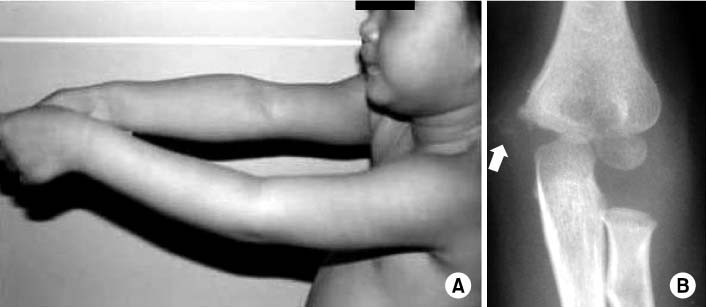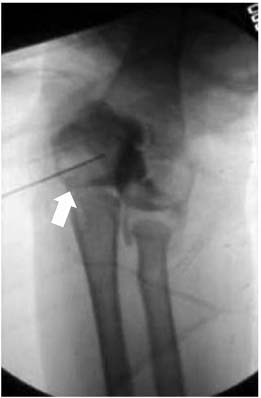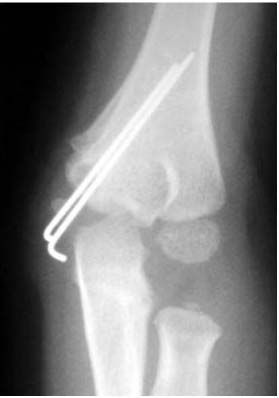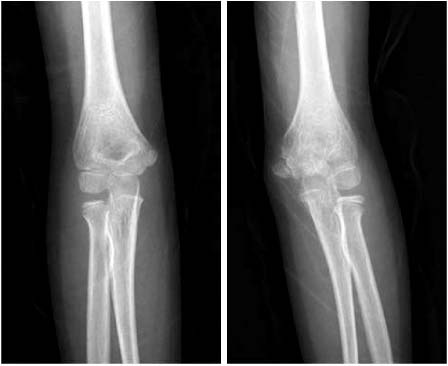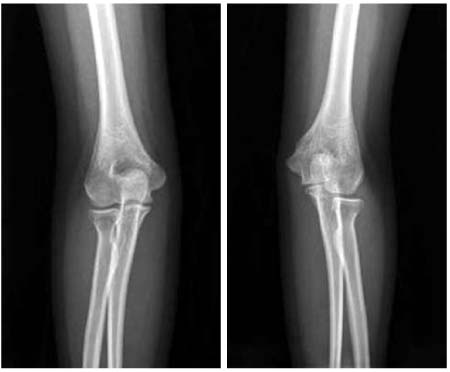J Korean Fract Soc.
2013 Oct;26(4):261-267. 10.12671/jkfs.2013.26.4.261.
Results of Treatment for Medial Condyle Fracture of the Distal Humerus in Children
- Affiliations
-
- 1Department of Orthopaedic Surgery, Pusan National University Hospital, Busan, Korea. kimht@pusan.ac.kr
- 2School of Medicine, Pusan National University, Yangsan, Korea.
- KMID: 2183826
- DOI: http://doi.org/10.12671/jkfs.2013.26.4.261
Abstract
- PURPOSE
We evaluated outcomes of treatment in medial condyle fracture of the distal humerus in children.
MATERIALS AND METHODS
Seven patients (4 females, 3 males) who were treated at the Pusan National University Hospital and followed-up until skeletal maturity after treatment were included. The average age at the time of fracture was 4.6 years (range, 2 to 10 years). Treatment was performed from 1 day to 6 months after the fracture: 4 patients underwent a surgical treatment for 17 days, 2 months, 2 months and 6 months after fracture, respectively. All fractures were Milch type 1. Five patients had Kilfoyle type 3, and two patients had type 2 fractures. Final outcomes were evaluated by the Mayo elbow performance score and carrying angle.
RESULTS
There were 3 excellent, 3 good and 1 fair result at the final follow-up. There was no elbow pain in any of the patients. One of the four patients who underwent a late surgical treatment received corrective osteotomy due to cubitus varus. All four patients had a limitation of elbow motion. The other three patients who had accurate diagnosis and treatment had a full range of motion.
CONCLUSION
Diagnosis of medial condyle fracture of the distal humerus based on plain radiograph is difficult in children due to its cartilaginous structures. When a patient shows pain, tenderness and swelling on the medial side of the elbow, an additional examination with magnetic resonance imaging may be required even if no fracture line is found in the radiograph. Accurate diagnosis and early treatment is important for good results.
Keyword
MeSH Terms
Figure
Reference
-
1. Bensahel H, Csukonyi Z, Badelon O, Badaoui S. Fractures of the medial condyle of the humerus in children. J Pediatr Orthop. 1986; 6:430–433.
Article2. Chacha PB. Fracture of the medical condyle of the humerus with rotational displacement. Report of two cases. J Bone Joint Surg Am. 1970; 52:1453–1458.
Article3. De Boeck H, Casteleyn PP, Opdecam P. Fracture of the medial humeral condyle. Report of a case in an infant. J Bone Joint Surg Am. 1987; 69:1442–1444.
Article4. Fowles JV, Kassab MT. Displaced fractures of the medial humeral condyle in children. J Bone Joint Surg Am. 1980; 62:1159–1163.
Article5. Ghawabi MH. Fracture of the medial condyle of the humerus. J Bone Joint Surg Am. 1975; 57:677–680.
Article6. Gogola GR. Pediatric humeral condyle fractures. Hand Clin. 2006; 22:77–85.
Article7. Hanspal RS. Injury to the medial humeral condyle in a child reviewed after 18 years. Report of a case. J Bone Joint Surg Br. 1985; 67:638–639.
Article8. Haraldsson S. On osteochondrosis deformas juvenilis capituli humeri including investigation of intra-osseous vasculature in distal humerus. Acta Orthop Scand Suppl. 1959; 38:1–232.9. Ingersoll RE. Fractures of the humeral condyles in children. Clin Orthop Relat Res. 1965; 41:32–42.
Article10. Ippolito E, Tudisco C, Farsetti P, Caterini R. Fracture of the humeral condyles in children: 49 cases evaluated after 18-45 years. Acta Orthop Scand. 1996; 67:173–178.
Article11. Kilfoyle RM. Fractures of the medial condyle and epicondyle of the elbow in children. Clin Orthop Relat Res. 1965; 41:43–50.
Article12. Leet AI, Young C, Hoffer MM. Medial condyle fractures of the humerus in children. J Pediatr Orthop. 2002; 22:2–7.
Article13. Lins RE, Simovitch RW, Waters PM. Pediatric elbow trauma. Orthop Clin North Am. 1999; 30:119–132.
Article14. Milch H. Fractures and fracture dislocations of the humeral condyles. J Trauma. 1964; 4:592–607.
Article15. Oppenheim WL, Clader TJ, Smith C, Bayer M. Supracondylar humeral osteotomy for traumatic childhood cubitus varus deformity. Clin Orthop Relat Res. 1984; (188):34–39.
Article16. Papavasiliou V, Nenopoulos S, Venturis T. Fractures of the medial condyle of the humerus in childhood. J Pediatr Orthop. 1987; 7:421–423.
Article17. Ryu K, Nagaoka M, Ryu J. Osteosynthesis for nonunion of the medial humeral condyle in an adolescent: a case report. J Shoulder Elbow Surg. 2007; 16:e8–e12.
Article
- Full Text Links
- Actions
-
Cited
- CITED
-
- Close
- Share
- Similar articles
-
- Early Corrective Osteoclasis for Malunited Pediatric Medial Condylar Fracture of the Humerus
- The Result After Surgical Treatment on Lateral Condyle Fracture of Humenu in Children
- A Comminuted Spiral Fracture with Butterfly Fragment of Distal Humerus by Arm Wrestling: A Case Report
- Ipsilateral Monteggia Fracture and Lateral Condyle fracture of Humerus in Children
- T-Condylar Fracture of Distal Humerus in a Child: A Case Report

